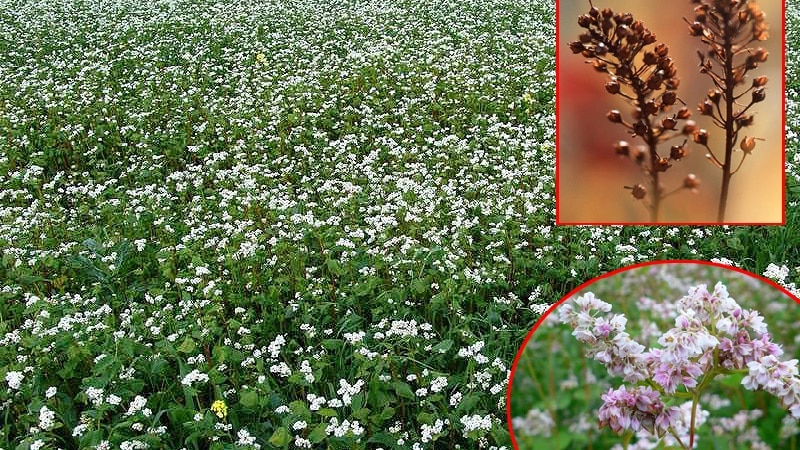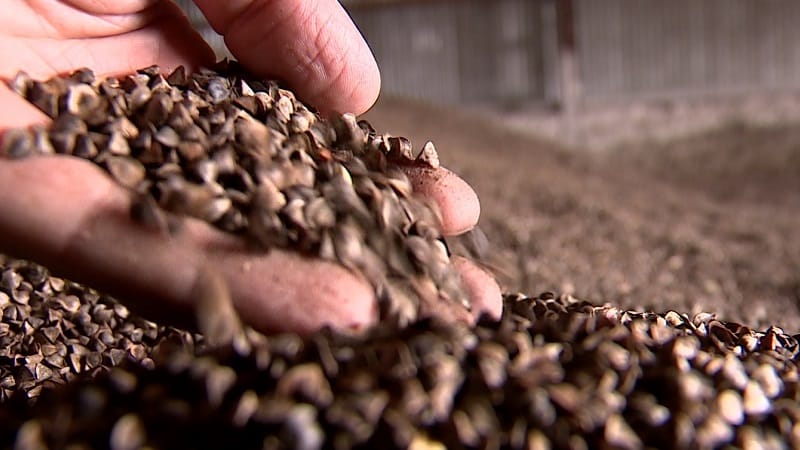Appearance and preparation of buckwheat seeds for sowing
Buckwheat is often grown in our latitudes. This is beneficial, considering the crop yield and the cost of cereals - it is 2-3 times more expensive than most grains. The plant itself is a tall reddish stem with heart-shaped lower leaves. Let's tell you how grow buckwheat and prepare the seeds for sowing.
What do buckwheat seeds look like?
In June – September, the plant appears in tassels with red, white, pink fragrant flowers. The fruits appear later and look like small triangular grains covered with a film. The color of the fruit is dark gray or dark brown. Each fruit is a core of two cotyledons and a root in a fruit shell.

Buckwheat ー not a grain crop, therefore it is correct to call its seeds fruits and not grains. There are two types of its fruits: aptera and alat.
Aptera - wingless type of fruit. The wings (fringes) can only be slightly seen on the ribs, which are more blunt and convex than those of the second type. The fruits seem to be swollen.
Alat-type fruits, on the contrary, are winged and sharp, with flat edges. Types differ in germination and climate requirements, so before purchasing, study tips on soil preparation and sowing.
Culture divided by type for common, multileaf and Tartary buckwheat.
Ordinary
The most common type of buckwheat is ordinary. The seeds in this case are plump and have smooth ribs. The stem is up to 1 m high, approximately 0.5 cm in diameter.
The leaves are drooping, up to 6 cm, the greens are tough with reddish veins.Requires high humidity and sunlight, so it is more common in mid-temperate latitudes.
Multileaf buckwheat
Multileaf plant (multifolium) - tall buckwheat with a lot of foliage, most often found in the Far East.
The stem of this species is already taller (about 2 m) and wider. The flowers are most often red, the leaves are long and thin.
The best varieties kind:
- Kama - up to 90 cm, with medium leaves and white flowers. Most often it produces 1 ton per hectare.
- Bogatyr is a tall plant with white flowers and very large leaves. High-yielding variety, record performance - about 10 tons per 1 ha.
- Dikul - on average 125 cm tall, with small leaves and pinkish flowers. Harvest: 1.7 tons per 1 ha.
- Sakhalinskaya is a very tall plant, about 3 m tall, found in the wild in the southern part of Sakhalin (hence the name). On average, it brings 3 tons per hectare.
Tartary buckwheat
A wild type of crop occurs in nature and very often interferes with the germination of grain and spring plants. Therefore it can be considered a weed.
The stems are green, not very tall (up to 80 cm), the buds are small and pale green, the panicles are loose. It grows wild along roads and on cliffs, most often in the USA and eastern Asia. You can also harvest from it - about 1.5 thousand fruits from each plant. The seeds themselves are wrinkled, dark gray, slightly elongated.
Preparing buckwheat seeds for sowing
If you are going to plant buckwheat on your site, it is better to take two varieties, suitable for climatic conditions and with different growing seasons. Before planting in the soil, they must be carefully prepared. The most important stages: seed selection, fertilizers, air treatment.

First class seed selection
Buckwheat is divided into two classes according to GOST, and for planting it is important to choose the best one. First class seeds - selected, with a high percentage of germination (95%). Purity percentage ー more than 99%; this means that only 20 seeds of other plants are allowed per kilogram and less than 10 weed seeds per 1 kg.
To get high yields, you need to focus on options with high germination (more than 92%). Buckwheat varieties differ in sowing requirements and yield properties, keep this in mind.
On the plant itself, fruits are formed in several places: on the main stem, on branches of the 1st, 2nd, 3rd order. Therefore, before planting seeds from the harvested crop, it is necessary to carefully review them and select the best ones. Large, heavy seeds will provide a yield one third higher than those sown without selection.
Air-thermal heating
After the best seeds buckwheat will be selected for sowing, and air-thermal heating will begin. For this they poured onto a flat, open area (preferably covered with a canopy) for several days. The weather should be warm (+20...+25°C) to keep them warm and ready for planting. Air humidity is not higher than 50%. Don't forget to stir them periodically. It is better to keep buckwheat seeds in such conditions for 3-5 days.
Treatment with microfertilizers
Before sowing, buckwheat seeds are treated and treated with microelements in order to increase field germination and disease resistance. Unfortunately, buckwheat is often susceptible to various diseases that interfere with the harvest.To avoid this, it is recommended to use any phosphorus-potassium or magnesium fertilizer together with a disinfectant (for example, “Alpha-Protravitel”, “Triton” or “Ranazol Ultra”) at the rate of 2 l/t (working solution consumption - 10 l/t of seeds ).
Treatment with fungicides
Fungicidal disinfectants have performed well in matters of seed germination and their protection from pests. The most common ones are Vincit, Vitavax and Quinto-Duo.
To prevent fungal diseases, the seeds of this crop are treated in advance (about several months before sowing) using a dry or semi-dry method. With the dry method, the seeds are mixed with antifungal drugs in special dressing machines; with the semi-dry method, they are immersed in an antifungal solution and then dried before planting.
Dusting is another option for processing planting material for better germination, when it is dry sprinkled with fertilizer powder. Various microfertilizers are suitable for dusting:
- manganese (manganese sulfate) ー dosage 50-100 g/c;
- zinc (zinc sulfate) ー 50 g/c;
- copper (copper sulfate) ー 50-100 g/c;
- boric (boric acid) ー 100-200 g/c.
Conclusion
Buckwheat seeds require careful processing, as they can be susceptible to various diseases. If you want to plant this crop on your site, do not forget to study all the features of the soil, storing seeds and the intricacies of harvesting fruits. Then it is possible to get a truly profitable harvest.